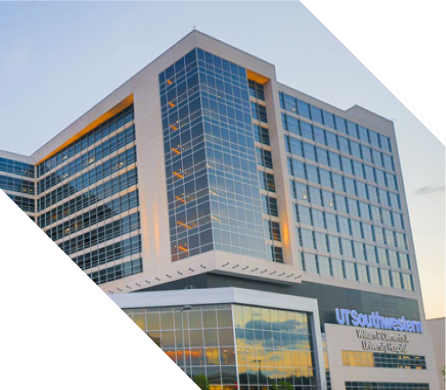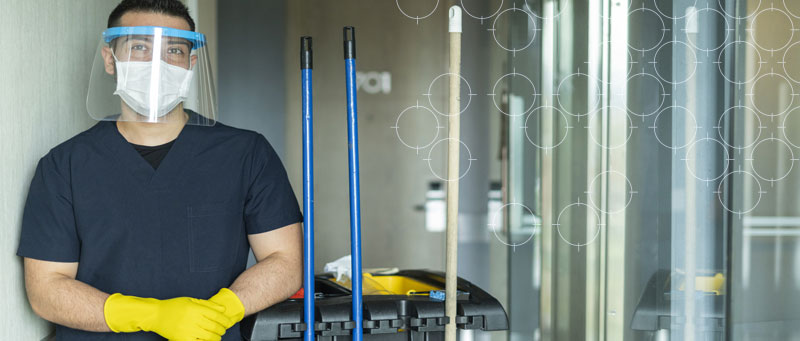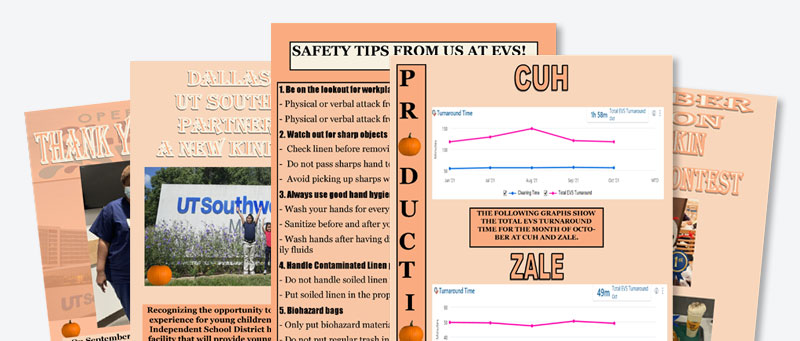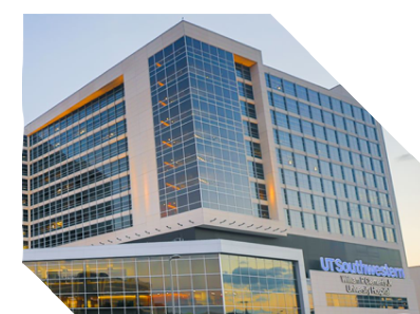How a Texas hospital improved cleanliness and HCAHPS scores

Insight
Every day, healthcare facilities strive to provide high-quality care in a safe setting, including preventing healthcare-associated infections. Environmental services (EVS) plays an important role in stopping the transmission of pathogens; however, EVS workers face multiple challenges from the pressure to turn around rooms quickly to unclear roles/responsibilities and high staff turnover. How can EVS leaders help remove the obstacles and keep people safe? For one experienced EVS director, it took starting from scratch to implement a successful cleaning and disinfection program.
This case study highlights the achievements of UT Southwestern Medical Center’s EVS team, outlining their adoptable actions and continuing journey.
Organization
UT Southwestern Medical Center
UT Southwestern, an academic medical center headquartered in Dallas, provides care at William P. Clements Jr. University Hospital, Zale Lipshy Pavilion, Southwestern University Hospitals & Clinics, Parkland Health & Hospital System, Children’s Medical Center, Texas Scottish Rite Hospital for Children, VA North Texas Health Care System, and other affiliated hospitals and community clinics. UT Southwestern physicians provide care to more than 117,000 hospitalized patients and oversee nearly 3 million outpatient visits a year.
Challenges
- Building an in-house EVS team after deciding to end contract with outsourced EVS
- Creating and standardizing protocols
- Raising patient satisfaction levels and cleanliness scores
- Engaging staff
Actions
- Increased the number of FTEs, defined roles and recruited a team
- Conducted cleaning and disinfection assessment and follow-up plan
- Hired an EVS educator to streamline onboarding and provide training
- Standardized protocols to cover three facilities
- Implemented employee engagement tools
Results
- Raised HCAHPS percentile rank from 2016 to 2021
- Improved ATP and Dazo scores
- Decreased room turnaround time
- Increased staff engagement and satisfaction
Challenges
In 2016, UT Southwestern leadership gave its outsourced EVS provider notice that the medical center was ending their contract because the company was not meeting service-level agreements. The low performance was reflected in the organization’s HCAHPS scores related to patient satisfaction with cleanliness, hovering at an approximate 28th percentile rank.
In November 2016, UT Southwestern brought on Mike Michalkowski as EVS director for three facilities: 751-bed William P. Clements Jr. University Hospital, 74-bed Zale Lipshy Pavilion and the two surgical floors of an outpatient surgery center. He faced the daunting task of recruiting in-house EVS staff, establishing policies/standards and implementing protocols for his new team.
As Michalkowski put it, “I told leadership to be prepared for a rough couple of years but that I would deliver results.”
From the start, Michalkowski realized he needed a larger team to cover the size and layout of the facilities.
“We had an allotment of 88 FTEs, which is based on square footage and is not enough,” says Michalkowski. “I continually received emails from staff apologizing for not being able to cover all assigned areas during their shifts.”
In addition, it wasn’t clear who was accountable when tasks weren’t done.

Actions
The first thing Michalkowski did was divide the hospital into parts, so that every floor had a supervisor assigned to it and a manager overseeing specific areas. This short-term fix provided some accountability as he started working on the long-term plan.
Michalkowski needed to identify the appropriate staffing level and be able to justify that number to administration. The timing was fortunate; UT Southwestern was partnering with Medline as the medical center brought the EVS program in-house.
A Medline EVS specialist helped Michalkowski determine the right number of workers he needed and a detailed position summary. Using multiple criteria, they determined that the number of FTEs should be increased from 88 to 189. By presenting a business case to administration, Michalkowski obtained the go-ahead and recruited for the positions.
Risk assessments reveal the good and the bad
By 2017, Michalkowski had a team and a patchwork of protocols. He was building strong working relationships with Infection Prevention managers and floor directors. He knew that EVS had areas for improvement and that a risk assessment was a good place to start. So, in June of that year, he brought in Medline product and EVS specialists to conduct a discovery assessment on UT Southwestern EVS processes, products and ATP scores to establish a baseline for risk.
Medline conducted education and training based on the results and conducted a follow-up assessment one week later. Improvements were dramatic, setting the stage for the final assessment one month later. As shown below, EVS staff made additional improvements in the final assessment.
1
Discovery assessment
Medline EVS and infection prevention specialists followed three EVS staff members in each of the two UT Southwestern hospitals and filled out an assessment on different process-related tasks. Then Medline used ATP to measure the soil level on all the CDC high-touch surfaces and took readings.
Here are the baseline results:
- Medium risk for product use—In both hospitals, staff used microfiber cloths and mops, which is the best material for soil removal. And they used appropriate disinfectant. However, surfaces stayed wet for the full contact time in only 25% of the tested rooms.
- Medium risk for ATP scores—Zale-Lipshy staff had a passing score for 12 out of 19 high-touch surfaces. Clements staff had a passing score for 7 out of 19 high-touch surfaces.
- Low risk for process—Zale-Lipshy staff cleaned 83% of high-touch surfaces. Clements staff cleaned 89% of high-touch surfaces.
The Medline team presented the results and follow-up plan to Michalkowski, which included recommending that EVS managers and staff participate in the Medline University course ERASE Pathogens and an in-service led by the Medline specialists.
“We took the Medline University course and attended the in-service,” says Michalkowski. And we started using Medline products, including the Microfiber Clean by Sequence™ Booklets, which ensure a separate cloth is used for each surface.”
2
Second assessment
Medline specialists repeated the process one week later at both hospitals.
Here are the results:
- Medium risk for product use—Full contact times were still lacking in the tested rooms.
- Low risk for ATP scores—Zale-Lipshy staff had a passing score for 15 out of 19 high-touch surfaces, up from the initial 12 out of 19. Clements staff had a passing score for 13 out of 19 high-touch surfaces, up from the initial 7 out of 19.
- Low risk for process—Zale-Lipshy staff cleaned 98% of high-touch surfaces, up from 83%. Clements staff cleaned 100% of high-touch surfaces, up from 89%.
Next steps included ensuring all staff took the Medline University course, implementing training during huddles on how to clean chairs and tray tables, and starting regular check-ins with staff on appropriate use of products.
3
Final assessment
Medline specialists repeated the process one month later at both hospitals.
Here are the final results:
- Medium risk for product use—Although EVS staff improved surface contact times, EVS management didn’t change all the products Medline recommended.
- Low risk for ATP scores—Zale-Lipshy staff had a passing score for 16 out of 19 high-touch surfaces, up from the initial 12 out of 19 and reflecting a 68.8% total reduction in ATP scores since initial assessment. Clements staff had a passing score for 13 out of 19 high-touch surfaces, up from the initial 7 out of 19 and reflecting a 75.1% total reduction in ATP scores since initial assessment.
- Low risk for process—Zale-Lipshy staff cleaned 100% of high-touch surfaces, up from the initial 83%. Clements staff cleaned 100% of high-touch surfaces, up from the initial 89%.
The Medline team recommended focusing on the importance of high dusting, continuing training during huddles on how to clean chairs and tray tables, and continuing check-ins with staff to ensure appropriate use of products.
Medline EVS and infection prevention specialists worked with two UT Southwestern hospitals using ATP to measure the soil level on all CDC high-touch surfaces, resulting in improved scores over 5 weeks.
Education moves to the forefront
In 2018 while preparing for a Joint Commission survey, Michalkowski knew he needed a manager to help take the EVS program to the next level. That May, he brought on Darrell Martin as an EVS educator, realizing that role would be more beneficial than one that was operations focused.
“We set up some guidelines and looked at our policies, which hadn’t been updated in more than 10 years,” says Michalkowski. “We cleaned up the guidelines and policies and started to streamline the process.”
Over the next six months, Michalkowski and Martin worked on standardizing protocols among the three facilities they covered. Martin also developed a rigorous three-week onboarding and training program for new employees.
“We invest 120 hours of training in staff, regardless of their years of experience,” says Martin. “And 90% of new staff have never worked in a hospital or worked in housekeeping at all.”
“Before you become an EVS director or manager, walk in the staff’s shoes to better understand the function.”
Mike Michalkowski
EVS Director, UT Southwestern Medical Center
New hires have 30 days to complete administrative onboarding tasks such as registering their vehicles and enrolling in benefits. Martin’s program ensures that these activities are completed in the first week. Also during the first week, EVS trainers provide an educational overview in a classroom-like setting, and new hires complete general EVS training.
The next two weeks focus solely on education and training. Here’s how it works:
- EVS supervisors receive a schedule for each new hire, which includes time in every area the team covers.
- EVS supervisors and “preceptors” (high-performing EVS staff) observe new hires as they clean, auditing and evaluating them and ensuring they can complete tasks independently. For example, the trainers observe how new staff enter a room and talk to patients. The preceptors also use ATP and Dazo to evaluate the cleanliness of an empty room the trainee has cleaned. Trainees need to receive at least a 90% to pass. If they get less than that, they go through training again.
- Once new staff pass their evaluations, they receive a permanent schedule. They are well prepared for their assigned areas, having spent time in each environment.
EVS trainers go through extensive training to ensure they are qualified for their role. Melanie Martinez is one of five EVS trainers. She had never worked in EVS before joining UT Southwestern.
“I went through the three-week training and then spent the next couple of months on the discharge team before becoming a trainer,” says Martinez.
Standardized protocols promote best practices
Michalkowski and Martin employ a seven-step cleaning process to ensure nothing is missed, regardless of the areas being serviced. They have received positive feedback about the clean by sequence booklets.
“Employees say the booklets make it easier to follow the process and understand why different cloths are used for specific tasks,” says Michalkowski.
In addition, using different colored cloths shows patients and their families that staff are not using the same cloth for the room and the bathroom.
“We used to use blue cloths for everything, which could give people the perception that we weren’t switching them out,” says Michalkowski. “Now we use different colors for different areas and tasks.”
Michalkowski’s EVS protocols also emphasize collaboration between EVS and Infection Prevention managers. With Michalski’s blessing, it’s Infection Prevention leaders, as opposed to EVS, who take regularly scheduled ATP and Dazo readings that are used for reporting.
“We work closely with Infection Prevention, and Mike is on the Infection Prevention Committee,” says Martin. “They meet and go over numbers, so we know how well we’re cleaning.”
Engaged employees have higher job satisfaction
In 2019, Michalkowski and Martin started conducting quarterly Glint surveys, which are used to measure employee engagement and overall satisfaction. Employee participation is encouraged but not mandatory.
“We have an 80% participation rate among employees, which is well above benchmark,” says Michalkowski.
Also above benchmark is the average satisfaction rate.
“When we first started, the satisfaction rate was 77%, which is a high percentage,” says Michalkowski. “We continue to average in the high 70s and low 80s.”
Michalkowski and Martin address any areas of improvement that staff cite frequently.
To engage staff throughout the three facilities, EVS produces a monthly newsletter that is distributed to EVS leadership via email and to staff in printed copies.

The monthly EVS newsletter, available to all staff, provides safety guidance reminders, EVS-specific benchmarks and information about hospital events.
“We want to inform everyone throughout the hospital about EVS happenings and hospital special events,” says Martinez. “We also use it as a rounding tool with our nurse leaders.”
Results
Michalkowski, Martin and the whole team have worked hard to realize measurable achievements, as shown by the numbers.
Higher HCAHPS scores
When Michalkowski joined UT Southwestern in 2016, the cleanliness HCAHPS score was in the 28th percentile rank. In 2021, the score is in the 68th percentile rank.
“My goal is to get to the 90th percentile rank,” says Michalkowski.
Higher Dazo scores and lower ATP scores
The EVS team improved its three-year Dazo baseline from 68.9 to 94.7 in 2021. During the 2017 Medline risk assessment, Zale Lipshy reduced its average ATP score from 457 to 158 across all surfaces. Clements went from an average failing score of 867 to an average passing score of 215 across all surfaces.
Reduced room turnaround time
EVS looks at turnaround times as “unadjusted” and “adjusted.” Unadjusted time takes out all the filters and encompasses the total time between start to finish of room turnaround. For example, if a discharged patient’s personal item is left in the room, EVS has to wait for a nurse to remove it. Adjusted time is the total cleaning and disinfection time only.
179 daily discharges
at Clements/Zale Lipshy hospitals
“When I first came in, our unadjusted turnaround time was 468 minutes,” says Michalkowski. “Right now, our unadjusted time is 142 minutes.”
While technology improves cleanliness, it adds time to the process.
“We use UV light devices in surgical areas, which adds 15 minutes to cleaning time,” says Michalkowski.
Even so, by adhering to streamlined processes, the team has reduced its average adjusted turnaround time from 75 minutes to 65 minutes. Michalkowski and Martin also streamlined the cleaning products being used, reducing the number of chemicals by half.
Increased employee engagement
In 2016, EVS staff participation in employee surveys was 10%, as opposed to the current 80% with the Glint surveys. And the 2016 satisfaction rate averaged in the low 60s, compared with today’s average in the high 70s and low 80s.
Looking ahead, Michalkowski would like the EVS team to be seen as a subject matter experts for the whole UT system.
“EVS currently has three divisions: university, research and hospital,” says Michalkowski. “I’d like to oversee all three divisions so we could standardize protocols and reduce costs. And everyone would know who they could contact for EVS solutions.”
Martin is proud of how ahead of the game UT Southwestern was when the COVID-19 pandemic started.
“In October 2020, the CDC recommended that EVS have comprehensive and standardized processes,” says Martin. “Everything they mentioned was what we had been doing since 2018.”
How can we help your business run better?
Contact us to learn more


